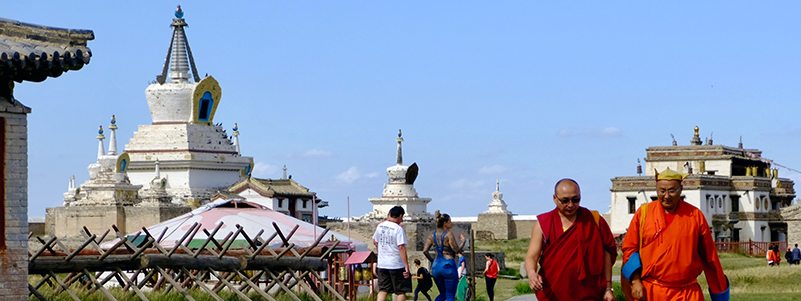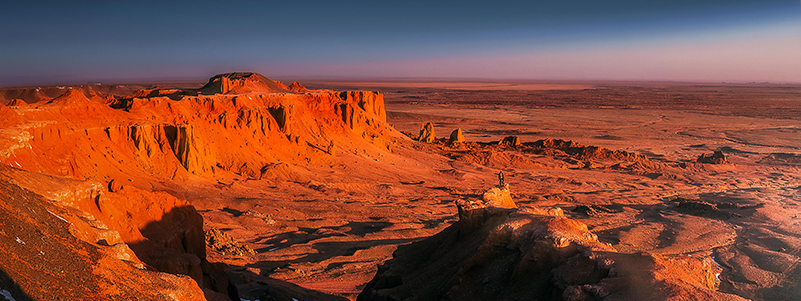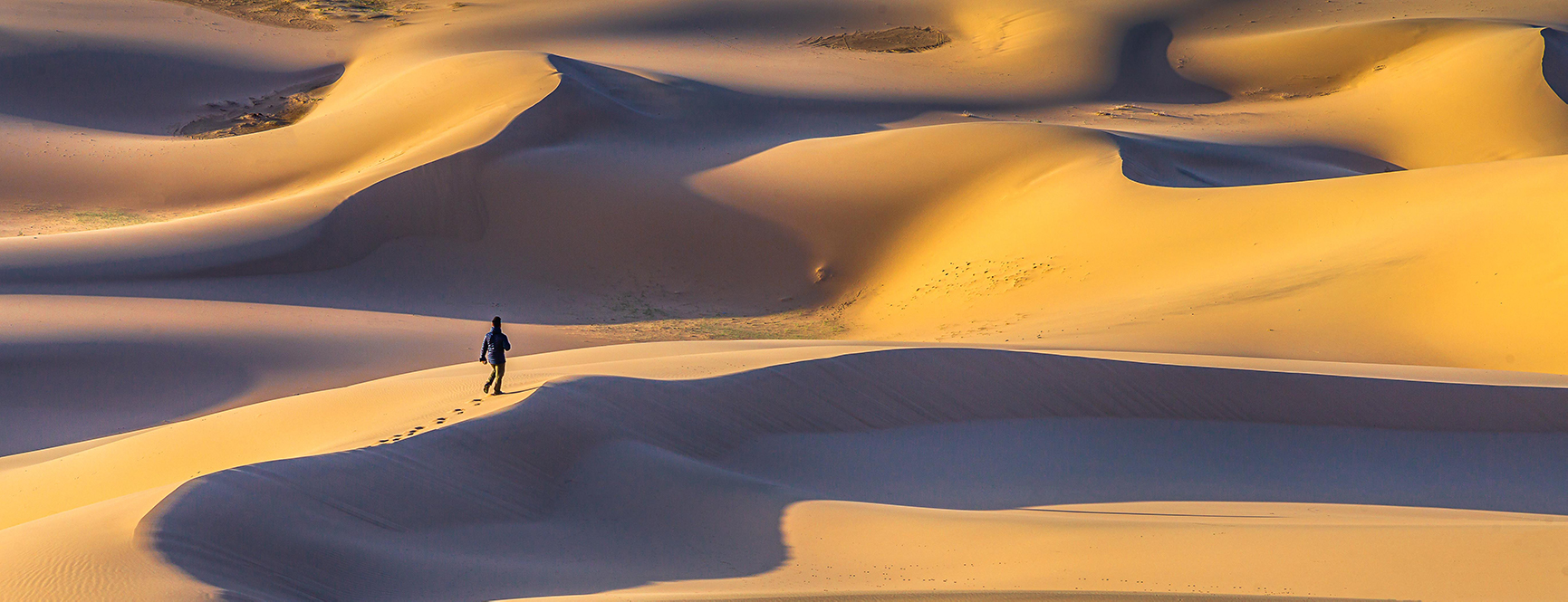Golden Circle Mongolia Tour with Naadam festival
13 days
Overview
Explore Mongolia, a vast and captivating land where each region offers its own unique allure. Starting from the bustling capital of Ulaanbaatar, journey across the central Mongolian steppes, where rolling plains are dotted with traditional ger camps and expansive herds of livestock. Discover the UNESCO-listed Orkhon Valley, a historical hub along the Orkhon River that was once the cradle of ancient nomadic empires. Here, you'll find the remnants of Turkic memorial sites, the ruins of a Uighur capital, and the historic site of the Mongol Empire’s capital.
As you travel, witness the dramatic transformation of landscapes—from lush grasslands to the arid Gobi Desert in the south. Experience firsthand how Mongolia’s nomadic families have adapted to these contrasting environments, preserving centuries-old traditions.
If you visit in July, don't miss Naadam, Mongolia's renowned annual festival held on July 11-12, with local celebrations throughout the month. Nomadic communities come together to celebrate “The Three Manly Sports” of wrestling, archery, and horse racing—a tradition dating back to the days of Chinggis Khan. Today, women also join in these ancient games, adding a modern twist to this rich cultural spectacle.

Date & Price:
Departing: 10-07-2026
Finishing: 22-07-2026
Status: Open
Price Per Person:
Includes:
- 3 overnights at 4* hotel in UB (twin)
- 1 overnight at the local family guest ger (twin/triple)
- 8 overnights at the Ger camp (twin/triple)
- All indicated meals ( B-Breakfast, L-Lunch, D-Dinner )
- Drinking water
- All visits, NP fee and sightseeing fees and Naadam festival ticket
- Comfortable 4x4 van including gasoline with experienced driver
- English speaking guide
- All airport transfers
Exludes:
- Travel insurance
- Optional activities (camel and horse riding...)
- Meals not indicated
- Drinks
- Gratuities
- Visa to Mongolia
- International flights &Travels
- Hotel early check-in and late check-out
- Other services not mentioned in the itinerary
Travel information:
- * Attend Naadam Festival in Mongolia which is inscribed on the Representative List of the Intangible Cultural Heritage of Humanity by UNESCO.
- * Meet and stay overnight with a modern nomadic family, explore their unique daily lifestyle
- * Visit "Kharkhorin" ancient capital of Mongolia
- * Visit Bayanzag nicknamed Flaming Cliffs by an American explorer named Roy Chapman Andrews who led an expedition team here in the 1920s.
- * Visit Khongor sand dunes. This long, narrow stretch of sand dunes continues for over 100 km with width of about few km to 12 km.
- * Visit Yolin Am, translated as Lammergeier’s Valley, named after a large species of bird also known as the “bearded vulture”
- * Visit Tsagaan Suvarga (White stupa) is a vibrant clay formation slope with a brink that is about 400 meters long and 60 meters high
Day 1 Arrival in Mongolia
Arrive in Ulaanbaatar, the capital of Mongolia. Our representative will pick you up from the airport and transfer you to a 4-star hotel located within the city center. Meet at the hotel lobby and the tour guide will lead you on a walking city tour including the main square with a grand statue of Chinggis Khan in front of the parliament building, the National History Museum introducing Mongolia’s history from early humans to the modern era, and the Choijin Lama Temple Museum displaying some of the best samples of Buddhist artworks. Then attend a show of traditional performances followed by a welcome dinner and tour briefing.
- D
- Hotel
Day 2 See the Naadam Festival in the Central Stadium
Meet with the guide and driver. Today we will visit to the Naadam Festival stadium. The national holiday Naadam is not only famous among Mongolians but also in the world. Many tourists, guests and journalists come to Mongolia to take part. The Festival starts with a transferring ceremony of the nine white banners from the Government House to the Naadam Stadium followed by a horse parade. Genghis Khaan used to use the nine banners during festive and peaceful times. Next, the magnificent opening ceremony starts. Traditional wrestling, archery and horse race are main highlights of the festival. As well as, you will see anklebone shooting and Naadam trade starting from Naadam main dish Huushuur, souvenirs, traditional clothes and much more. In the evening attend a show presenting traditional performances consisting of music, throat-singing, dancing, and contortion followed by a dinner at local restaurant.

- B.L.D
- Hotel
Day 3 Go to the horse-race field, drive to Elsen tasarkhai (little gobi)
Our guide and driver will pick you up early in the morning and drive outside west of Ulaanbaatar to the horse-race field. There are 6 races categorized by the horses’ age and race distances are between 15 and 30 kilometers depending on the age group. The jockeys are children usually between the ages of 9 and 12. While waiting for the race, the area is bustling with interesting activities such as folk and horse shows, festive foods, souvenir sales, and mini-games for spectators to partake in. Then continue driving about 250 km west from the city to Elsen Tasarkhai, which is an area with patches of sand dunes in the middle of the grasslands. Here you will stay overnight with a local herder family and learn about the Mongolian traditional culture and nomadic lifestyle. If you would like, horse riding can be arranged. This evening, spend time with the family learning about their daily chores such as animal milking, livestock tending, and cooking traditional food. This evening you will stay in a ger, which is the round-shaped Mongolian traditional felt dwelling.
- B.L.D
- Local family
- 300 km
Day 4 Drive to Kharkhorin town
Continue further west to Kharkhorin, a recent town named after and located adjacent to where the ancient Mongol capital Kharakhorum once flourished. The second son of Chinggis Khan founded the capital in the early 13th century before it was destroyed by the Chinese Ming Dynasty in late 14th century. Today the main attraction here is the Erdene Zuu monastery center, established in 1585 as introduction of Tibetan Buddhism as Mongolia’s main religion by a Mongol Khan. This monastery center was constructed from ruins of the ancient Mongol capital. A section of the monastery complex is now a museum displaying Buddhist artworks while other monastery buildings are active with monks doing their daily practices. There is also a visit to local Kharakhorum museum.

- B.L.D
- Ger camp
- 90 km
Day 5 Ongi monastery ruins in the semi-Gobi
Ongi monastery consists of ruins of two monastery complexes on either side of the Ongi River. Ruins of the older Khutagt monastery complex, founded in 1660, which consisted of various administrative buildings as well as 11 temples sits on the southern bank while ruins of the later 18th century Barlim complex which consisted of 17 temples sits on the northern bank. During the communist anti-religion purges of the 1930s, both complexes were completely destroyed. Following the introduction of democracy, revival of Buddhism took place beginning in the 1990’s with reconstruction and re-opening of some monastery centers across Mongolia. Ongi monastery followed along with commencement of a newly built temple in 2004.
- B.L.D
- Ger camp
- 320 km
Day 6 Flaming Cliffs
Drive to Bayanzag, nicknamed Flaming Cliffs by an American explorer named Roy Chapman Andrews who led an expedition team here in the 1920s. He was a proponent of Out of Asia theory of humanity’s origins. And whilst searching for remains of earliest humans, which they did not find, the team instead discovered the first recorded fossilized nest of dinosaur eggs here at this site along with other dinosaur fossils.

- B.L.D
- Ger camp
- 180 km
Day 7 Singing Sands
Our next destination is the Khongor sand dunes overlooking the green meadow of the Khongor river. This long, narrow stretch of sand dunes continues for over 100 km with width of about few km to 12 km. From flatland to the highest ridge is around 200 meters. In the late afternoon, you can try to climb up to one of the crests or walk the lower slopes and enjoy the surrounding view. It’s also called the “Singing Sands” due to a distant propeller hum heard when strong winds push tons of sand grains down steep slopes thus causing friction and producing small tremors.
- B.L.D
- Ger camp
- 160 km
Day 8 Rest at the Singing Sands
Free day at the Khongor sand dunes.

- B.L.D
- Ger camp
Day 9 Hiking in the Lammergeier’s valley
Drive to Yolin Am, translated as Lammergeier’s valley, named after a large species of bird also known as the “bearded vulture” which glide over the gorge where they live and breed on crags of its high mountains. Lammergeiers mostly feed on bones. They can swallow whole or bite through brittle bones and its powerful digestive system quickly dissolves even large pieces. If a bone is too large to swallow, they carry it up and drop it down onto rocks below to smash it into smaller pieces. Nestled within the Three Beauties Mountain range, the narrow part of this gorge shelters ice until July despite the hot desert temperature. The stream that flows through, the lush valley and its surrounding mountains altogether is an oasis in the middle of the desert with diverse wildlife.
- B.L.D
- Ger camp
- 180 km
Day 10 Drive to the White Stupa cliffs
Drive to Tsagaan Suvarga, translated as the White Stupa in English is a vibrant clay formation slope with a brink that is about 400 meters long and 60 meters high. This naturally occurring formation once was part of a seabed aeons ago. Ores exposed to oxygen created the differing purple, orange and reddish hues that make it stand out amongst its surrounding flat expanse.

- B.L.D
- Ger camp
- 215 km
Day 11 Drive to Baga Gazariin Chuluu
Baga Gazariin Chuluu is a 15 km long and 10 km wide granite massif encompassing an area of about 300 square kilometers. These unique rock formations create a labyrinth with its gorges, thus making it stand out from surrounding semi-desert steppe terrain. There is ruin of an old monastery center here and other interesting spots including rock paintings and a spring locals claim is good for eye health.
- B.L.D
- Ger camp
- 240 km
Day 12 Drive to Ulaanbaatar
Drive back to Ulaanbaatar. Transfer to hotel and rest until farewell dinner.

- B.L.D
- Hotel
- 250 km
Day 13 Departure
Pick up from the hotel and transfer to the airport for your departure flight.
- B